- Author
- A.N. Other
- Subjects
- History - pre-Federation
- Tags
-
- RAN Ships
- None noted.
- Publication
- March 2022 edition of the Naval Historical Review (all rights reserved)
By David Payne
The First Nations people of Australia and Torres Strait have a history of settlement spanning at least 65,000 years. They are the world’s oldest living culture and their stories go back through time to that beginning, crossing from Indonesian islands to Suhal, the combined continent of Australia and Papua New Guinea. It was a settlement facilitated by watercraft with possibly the first open water passages made by any people. Watercraft are clearly an important part of their community. Their new coastal and inland waterways had resources and were pathways for movement, trade and social interaction.
This is an examination of the diverse variety of contemporary Indigenous watercraft from the Australian and Torres Strait Island communities. These are the craft that have been recorded over the last few hundred years, but many still exist and are still able to be built by the communities they come from. As such it represents only what we know of now, but like their builders, they are craft that must be related back through the generations to the people and craft used in that first crossing, and have since evolved from them.
The narrative that follows is told in modern day terms. Where possible community and craft names are noted, however variations in the spelling continue to evolve. It begins by exploring the variety and diverse nature of Indigenous watercraft throughout the mainland, Torres Strait and Tasmania, observing both the connections between craft and the sudden changes that occur in their distribution. This diversity holds a rich collection of individual craft and the story of their design and construction is an education in sound engineering and sustainable practices.
Their rough nature on the surface seems to hide what is an advanced understanding of both the structural and hydrodynamic requirements for a vessel that must operate in the water and the qualities of the materials available from which to build them.
The diverse nature of these craft represents how separate communities arrived at their own style of craft that is closely related to their environment. They are craft whose design comes from a thorough understanding of the regional geography and botany of where the communities live. All are appropriate to their role. They are sustainable, a modern byword now accepted widely as a concept to adopt wherever possible, yet it was already being practised on this continent by the Aboriginal and Torres Strait First Nations people for tens of thousands of years.
Distribution of Watercraft
The distribution of watercraft around Australia is rich and extensive. They may well have existed and evolved in some form ever since the First Nations people arrived, despite no direct archaeological evidence other than the contemporary craft. In contemporary times the watercraft were gradually recorded in journals and logs, then research papers. Today there are still many people who are unaware that any Indigenous water craft even existed.
The craft have been studied a number of times with basic maps that show some of the types and locations. By drawing them individually, based on documented images and descriptions, it is possible to go deeper into the broad types and discover the individual variation that often exists within distinct types.
Freshwater communities
The freshwater, south east inland river system we know as the Murray Darling is the primary freshwater region that supported communities with watercraft. Evidence from elders also connects similar craft to the rivers flowing toward Lake Eyre in central Australia. It is home to a distinct type, a single sheet of smooth bark formed into a boat shape and sometimes known as a yuki, the name used by the Ngarrindjeri people on the lower reaches. Whilst it is commonly known that river red gum was used for their construction, it is less well known that one or two other barks were also available and used.
Saltwater communities
The great majority of watercraft belong to coastal, saltwater communities, and as can be seen on the map, their distribution covers over 2/3 of the coastline. Bark canoes are the most numerous type, along with dugouts, outrigger canoes and rafts.
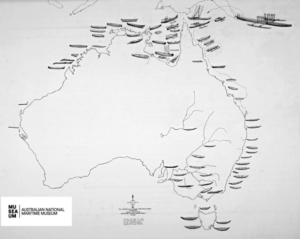
Tasmania is home to a distinct type of bark canoe; the rolled bark canoes are called ningher in one SE Tasmanian community language. Their relatively solid, three-part configuration is quite different from other bark canoes on the mainland and research is showing how different material choices, locations and uses gave subtle variation to the form within the overall concept of a bundles of buoyant material strapped together, then finished with a layer of stiffer bark
On the mainland along the eastern coastline of NSW and Victoria the tied-bark canoes offer a good example of individual variation within a shared concept. The tied-bark type ranges from the Boonwurung and Kurnai communities in SE Victoria up along the coast as far as the Gubbi Gubbi and adjacent communities near the Fraser Island region in Queensland.
All these craft have the ends folded and tied together after the ends have been thinned down, and the bark is heated by fire to help make it more supple. They are often both tied and fastened with a peg through the folds, and have minimal framing inside the hull. There are variations in the proportions, details of the ties and the method framing. On parts of the NSW north coast the folds appear quite small and the bound ends are also turned upwards with a crease across the hull. From about Lake Macquarie south, the crease disappears and the folds become a bit wider. Ring frames with ties across the top pulling the frame and sides inwards appear in these craft, alongside the beam and tie system that is simpler to make. Gippsland craft show evidence of being quite long, and having their ends very tightly tied.
In most communities the bark sheet cut from the tree is then inverted to form the craft, and thus the inside surface of the bark becomes the outside surface of the canoe.
Along the north-eastern Coral Sea and Great Barrier Reef coast of Queensland the diversity of bark canoes begins with marked change from the tied-bark canoes have come up about as far as the communities adjacent to Fraser Island. To the north including the area around the Percy Islands and the Daumbal community, a much more complex three-panel, framed bark canoe occurs over a small section of the coast. Then, further north the sewn bark type appears and is the main bark canoe type. The principal element of these sewn craft is a neatly sewn join at the ends, bringing the panels together to form a bow and stern with a sharp vertical end.
Torres Strait and nearby areas of Cape York’s coastline are home to outrigger canoes. The Torres Strait examples are the most sophisticated, and their construction is closely related to the indigenous communities in nearby Papua New Guinea. Traditionally the main hull was made by a Fly River delta PNG community in exchange for shell and other trade items from the Torres Strait island seeking the new canoe. The final arrangement of outriggers, platform and sails were completed by the Torres Strait Islanders.
Different types of outriggers continue to be built by Aboriginal communities along the Cape York coastline. These show as simpler forms of single and double outrigger canoes, using dugout logs from the local region. They share the waterways with the sewn bark type, providing a distinct comparison of materials and technology.
The top end of Australia, from Cape York and Torres Strait across as far as the Kimberley and Broome regions takes this comparison of different types sharing the coastline and waterways even further. Sewn bark canoes in a variety of distinct profiles and framing techniques exist from the Tiwi Islands in the west across to Cape York in the east, but all sharing a sewn method of joining the sides to form the two ends, and even joining panels of bark together to form a canoe shaped hull. The evidence currently points to them pre-dating the introduction of the Macassan style dugouts seen throughout this region. The dugout canoes on the whole appear quite similar in construction and shape, another point of comparison with the sewn bark ones and their variation in style. On the western side of Cape York, they have adapted dugout canoe hulls with the addition of simple outriggers to form a more stable outrigger craft.
Add to all of this the distinct raft types that would have co-existed in the same time frame as the sewn bark canoes, and well known in the King Sound region of the Kimberley’s where the Bardi community’s kalwa, galwa or kawlum double raft was used. Research is showing some variations of this type further to the west. Rafts are also represented by the vee-shaped walba, walpa and walpo types from the lower Gulf of Carpentaria’s Lardil and Gayardilt Mornington Island communities
In addition to this, throughout Australia there seems to be consistent evidence of simple rafts and swimming logs being used as almost spontaneous construction to suit the moment and perhaps only used once or twice.
It seems that two thirds of the country have an array of specialised craft, but the south west quadrant remains empty of evidence. It is a rugged coastline that would not be easy to use beyond the beaches, yet the existence of estuaries such as the Swan River where calm conditions prevail begs the question-were their craft that plied these waterways, but not recorded by early explorers? Community stories suggest that even in these estuarine areas there were no canoes as the water was often shallow and everything that was needed could be sourced without requiring a watercraft.
Overall, the map tells a story of the types, where they are related but also where there are distinct changes, but in this form does not show how this might correlate to communities, and to the environment. It needs an overlay with both, to see how they could inform us further about why the variations might exist. A study of stringybark for example shows it provides a good material over a range of similar trees from South Australia though to the top end, but how the pliability and other factors within the material compares, and how does this then relate to the eventual shapes and construction methods is worthy of further investigation.
This area is one where the results could help a much bigger picture than this map. If we compare the known evolution of the Australian environment since occupation with its current state, which has existed in relative stability for about the last 7,000 years, then we may have a new understanding of the possible chronology and age of these watercraft.
Design and Construction
Design by accident is an accident waiting to happen, vessels are a significant structure that needs to closely observe engineering practicalities to hold together, and they also need to observe vessel design factors in relation to their volume and shape to float and make progress on the water.
A boat is a surprisingly complex item. It has to be shaped to have:
- Enough volume to support the weight of the vessel and its load
- Enough freeboard in reserve to accommodate waves
- Enough stability
- A shape to go through waves and water easily
- A shape that is controllable
This shape has to be built strong enough to:
- float in the water and support those in it
- accommodate changes in loading due to waves and being propelled
- be handled in and out of the water and stored on shore
If there is one thing that stands out as a priority – there has to be enough volume to support the weight of the craft and what it will carry, the remainder is fine tuning the shape of that volume and the hull overall to work better, and having it strong enough for its task and environment.
Instead of talking about weight, vessel designers talk about displacement, meaning how much water is displaced or pushed aside when a vessel floats. Think of it as the hole or shape created in the water by the object that’s floating, if it were a ball it could be half the shape of the ball. With a boat, the shape is the part of the boat below the waterline. Whatever the case that volume is the important consideration, and when weighed that volume of water pushed aside or displaced is always equal to the weight of the object that created the hole – that is the basis of Archimedes principle. Therefore, a canoe or raft has to have enough volume to support its own weight and the added weight of the people and whatever else it carries.
All the watercraft in Australia recognise the many requirements beyond just the volume; they have the necessary engineering and hydrodynamics within them, and it seems most likely this was determined and understood through observation. From there the craft kept to a plan that was practised and renewed through the continued seasonal construction of the craft, with the information handed down by the older people to the younger people. The plan and the information was not drawn or written down – it was spoken about, described, modelled or demonstrated, then finally acquired by participation, at which point this plan had been learnt. The plan was kept as knowledge within each community, and it was shared and passed on, ensuring continuity and community cohesion.
THE TYPES OF WATERCRAFT
Canoes
To show how these craft have been developed to a high degree yet often appear quite simple an excellent starting point is to look at the yuki from the Murray River. This shell-like craft can be classed as a monocoque construction, whereby the panel is strong enough by itself to support the load with minimal or no support structure. The term comes from a combination of Greek and French, coined when the French created monocoque panels for aircraft in the early 1900s, and it was considered a very advanced method of building at the time. Essentially it is a shell or ‘stressed skin’ form of construction, where the shell supports the loads. Characteristically there are large panel areas spanning between the bare minimum of frames and longitudinal supports, perhaps none in some designs. Monocoque construction has had a resurgence of use with composite fibre reinforcement panels, and is now well known for its use on dinghies, yachts, powercraft and other vessels.
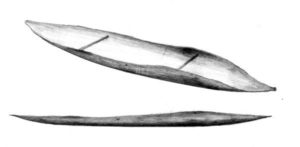
Clearly the concept is much older, and was also well understood by Indigenous Australians. Bark is essentially a fibrous material with much of the orientation up and down the tree or along the panel when it is cut, but the interwoven nature gives a good cross connection, and allows it to bend easily athwartships, while remaining stiff fore and aft.
The bark with the desired thickness and pliability for the different bark canoes comes from a small number of species, mostly eucalypt, and this again is highlighting how well the Indigenous people know the trees and their characteristics.
A yuki is generally made from red gum Eucalyptus camaldulensis and can be a shell that is 25mm thick. Coming off the tree as a relatively rigid sheet the canoes often have just two beams holding the sides apart.
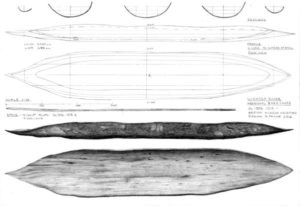

The nawi tied bark canoe and the nardan sewn bark canoe use slightly thinner and less stiff stringy bark. These two types are essentially a body with a long monocoque panel between two transverse supports or frames, one each across the hull toward each end. The edge may be reinforced at the gunwale with an additional long thin sapling or branch tied to it.
The tied bark canoe employs strips of bark tied around the ends of the hull to close them off, and create a shell which is then supported by frames or beams with cross-ties pulling the sides together, hence the modern reference to the word tied. The same bark strips can also be easily woven into a rope, but either form has sufficient strength to secure the craft together.
A sewn bark canoe has perhaps a little more finesse to our eyes. The ends are closed off by sewing them together, with a very neat line of stitching. The holes and sewing are made with awls and the thread of rope passed through with needles and many of these implements were made from sharpened bone. The rope fibre was fabricated from vines or bark, and the stitching varied from simple to complex patterns and joints were made watertight with natural resins.
In the nawi and similar tied bark canoes, stringybarks were used in most areas, including yellow stringybark Eucalyptus acmenoides, Eucalyptus muelleriana, and Eucalyptus umbra, white stringybark Eucalyptus globoidea and possibly blue-leaved stringybark Eucalyptus agglomerata. Swamp mahogany Eucalyptus robusta and some other eucalypts variants have also been recorded. Davidson quotes his native sources indicating that Mountain Ash Eucalyptus regnans, a variety of blue gum, a white gum from the valleys and Snowy River mahogany were used as well. The ends are folded into a series of vertical panels, like a small fan, and to create these folds it is necessary to reduce the bark thickness significantly. However, the orientation of the now vertical folds creates the necessary stiffness lost earlier with the reduced thickness. In the process of creating these folds, which are tied together tightly at each end, the transition of the cross section from a rounded hull into the folded end brings the bow and stern up which then gives a good hull shape for riding over waves.

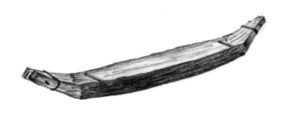
The nardan and related gumung nardan from Arnhem land Yolngu communities highlight the understanding of the detail sometimes needed to optimise a craft for a purpose. They are built from Darwin stringybark Eucalyptus tetradonta.
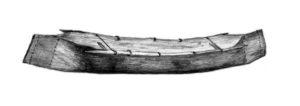
The nardan was used on the coast and adjacent estuaries, and has a simple vertical fold and crease at either end with a long almost parallel section through the main part of the canoe’s body. This was easily sufficient for negotiating the relatively smooth water conditions commonly experienced there. Inland along the Glyde River and into the Arafura swamps the nardan was modified to negotiate the floodplains in the wet season when the men in the community hunted magpie geese and collected their eggs as they nested in the flooded grasslands. The creased bow was made longer with the crease located a little further aft, and then the bow it was cut back on the top edge to form a sharp, reverse bow profile. This shape parted the grass easily as they poled their canoes through the shallow flooded areas in search of geese and their nests. Out in open river reaches they sat in the craft and paddled them by hand or with bark paddles.
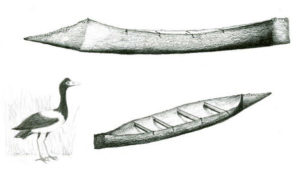
Many of the tied-bark and sewn bark canoes share another well thought out characteristic. The bark cut from the tree is inverted to form the canoe hull. Initially the bark comes off the tree like a cylinder with a cut down the middle if the whole tree is ring-barked, otherwise it comes off in a partial cylinder shape. This curved cross-section of the bark is then allowed to flatten out, assisted by taking off the dead exterior layers, and then once inverted, it is curved back upwards for the shape of the canoe. This takes advantage of two things. Firstly, it presents a smooth and resin rich waterproof surface, good for paddling more easily and keeping the craft watertight. However another advantage is that it preserves the integrity of the strongest fibres in the bark for the full length of the canoe, because the areas thinned down take away layers of older fibre that as they decay and become part of the outer surface of bark, loose their strength.
At the top end of the continent the many coastal craft are a bit more complex. The sewing technique for the ends is more detailed than the simpler folds and ties of the east coast craft and many have a distinct profile shape as well, such as the fish tail ends on the Tiwi Island craft. The seam is very tight and caulked with natural materials. This hull has straightforward supports as well with an unsupported panel across the middle, but on the Arnhem Land coast line, their sewn bark canoes have crescent ends and a number of small frames bent into place, creating a more sophisticated structure. This often relates to a thinner bark being used and needing more support, but It even poses the question as to whether they have taken on some recent influence from Asian or European framed craft after contact was made with their technologies.
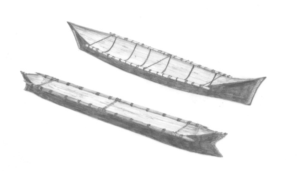
The cross sections of the many canoe types reinforce this message moving from simple to complex, and again show the width of the unsupported, monocoque panel so common to bark canoes.
The cross sections of the many different types of construction also show how the principle of bracing through triangulation for extra support was also widespread, but restricted to the northern craft. There are both intricate and simple ways of creating a linked, triangular support with branches and ties, held in place with tension and compression members, simple engineering in some respects, but clear evidence that they understood how to use these foundation stones of structural design.

The three-panel canoe from the east coast of Queensland is an intriguing craft with a unique construction that lies between the single sheet supported by branches used by the tied bark and sewn bark canoes from communities to the south and north respectively of the small length of coastline they are found, which includes the Percy Islands offshore. They are made from eucalyptus ironbark species, a tough and relatively rigid bark that lends itself to being left as flat panels with a shallow curvature along the longer axis. The straight line, single chine cross section and construction that has been developed to use this material has branches reinforcing the chine corners and gunwale edges that are neatly sewn to the panels, plus a strong tensioned frame about the middle. This creates a deep, seaworthy craft reflecting a high degree of complexity. More study is needed on the origins of this, and how its shape and construction might relate to other artefacts made by the communities who build these intriguing craft.
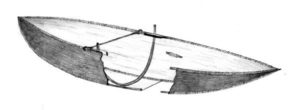
The rolled bark canoes from Tasmania tell a different story for floatation and stability, where the thin sheets of bark or strands of reed that form the craft also form or bulk out the volume that is the displacement needed to support its weight and anyone on board. The actual displacement volume is porous and thus difficult to estimate as it is very dependent upon how tightly the reeds or bark is rolled together to minimise spaces that would fill with water as the craft entered the sea. Each craft would have varied, some better at floating than others, but their substantial size may be one element that reflects the difficulty in achieving volume.
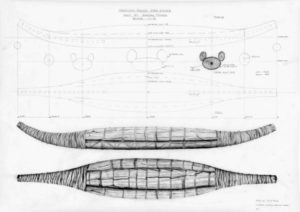
A section through a rolled bark canoe shows the two outer hulls or sponsons around the main hull, creating on one hand a cockpit area protected from waves, but equally important, the volume out wide these hulls provide adds hugely to is stability. It is an idea seen again in a section through a modern polyethylene sit-on kayak where a lot of stability is provided by adding a section at water level on the outer side of the main hull, so that the craft are safe and usable by a wide range of people. At two ends of the time scale the same idea is being used.
However, an overall observation of the environment they are often used in and how well the shape is adapted to this is a consideration to be acknowledged. These craft when taken offshore of the coast are in a region where storms and strong winds can come up suddenly, and rough seas are very common. In these conditions an open canoe such as a tied bark canoe is vulnerable to being swamped on many occasions. However, the solid shape of these rolled bark canoes would allow waves to roll over them and they remain buoyant after the wave has passed and the water trapped between the side sponsons has drained off through the gap between them and the main hull.
Part Two of this series is to be continued.




